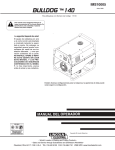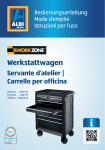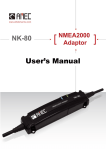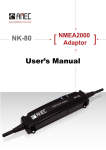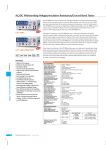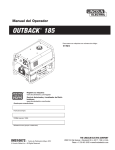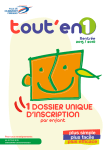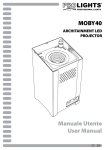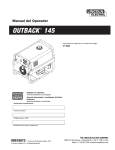Download MAINTENANCE INTERVALS - Safety
Transcript
MAINTENANCE INTERVALS Operation and Maintenance Manual Excerpt © 2010 Caterpillar All Rights Reserved ® ® SEBU7420-08 November 2009 Operation and Maintenance Manual S305, S320, S325, S340, S365 and S390 Demolition and Scrap Shears BRD1-Up (S305) CDX1-Up (S320) CFW1-Up (S325) CKY1-Up (S340) CLE1-Up (S365) FDK1-Up (S390) SAFETY.CAT.COM 34 Maintenance Section Maintenance Interval Schedule SEBU7420-08 i03755907 Maintenance Interval Schedule SMCS Code: 6700 When Required Access Cover - Remove/Inspect .......................... Cutting Arm Preload - Adjust ................................ Jaw - Repair .......................................................... Rotator Head Bolts - Replace ............................... 35 42 46 57 Every 8 Service Hours or Daily Bushings - Lubricate ............................................. Cutters - Inspect/Replace ..................................... Cutters - Inspect/Replace ..................................... Cutting Edge Screws - Tighten ............................. Gear and Bearing - Lubricate ............................... Gear and Bearing - Lubricate ............................... Gear and Bearing - Lubricate ............................... Gear and Bearing - Lubricate ............................... Hydraulic Fittings - Inspect ................................... Wear Plates - Inspect/Replace ............................. Wear Tip - Inspect/Replace .................................. 35 36 40 43 44 44 45 45 46 58 60 Initial 20 Service Hours Hub Nut - Check/Tighten ...................................... 46 Every 10 Service Hours or Daily Rotator Head Bolts - Inspect ................................. 57 Initial 25 Service Hours Jaw - Repair .......................................................... 46 Every 100 Service Hours Rotator Head Bolts - Check .................................. 56 SEBU7420-08 35 Maintenance Section Access Cover - Remove/Inspect i02236649 Access Cover Remove/Inspect i01439514 Bushings - Lubricate SMCS Code: 6700-086 SMCS Code: 6344-011-AO; 6344-040-AO Illustration 45 Illustration 44 g01029345 g00754434 1. Close the jaw of the shear. Remove the Access Cover 2. Place the shear on the ground. 1. Use an allen wrench to loosen the bolts (3). Loosen the bolt until resistance is felt. 3. Turn off the engine of the host machine. Release the hydraulic pressure in the hydraulic system. Refer to the “Service Manual” of the host machine for the proper procedure to release the hydraulic pressure. 2. Push down the bolts. Turn the bolts by 180°. 3. Remove the access cover (1). Install the Access Cover 1. Install the access cover (1). 2. Push down the bolts and turn the bolts until the latches(2) are visible through the slots (4) at the edge of the access cover. Note: If the latches are not visible through the slots (4) at the edge of the access cover, the access cover will not lock in place. 3. Use an allen wrench to tighten the bolts (3). Tighten the bolts until resistance is felt. 4. Clean the fittings with a clean rag before you lubricate the fittings. Note: In order to access the fittings on the pin for the cutting jaw, you must remove two caps. There is one cap on each side of the pin. 5. Lubricate the five grease fittings. There are two fittings on the pivot pin for the cylinder (1). There is one fitting on the end of the cylinder (2). There are two fittings on the pin for the cutting jaw (3). 36 Maintenance Section Cutters - Inspect/Replace SEBU7420-08 i02236658 Cutters - Inspect/Replace SMCS Code: 6801-040; 6801-510 S/N: BRD1-Up S/N: CLE1-244 S/N: FDK1-344 S/N: CFW1-207 S/N: CDX1-124 S/N: CKY1-181 Illustration 47 Hydraulic cylinder for S320 through S390 Inspect the Cutters Table 9 (1) g00763257 Sales Model Shear Locks S305 199-8486(1) S320 200-2959 S325 200-2960 S340 200-2885 S365 200-2961 S390 200-2962 1. Open the jaw of the shear. The following procedures describe maintaining the jaw in the open position. a. In order to hold the shear in the open position for the S305, install 198-7100 Bar through the holes in the frame of the shear. Refer to Table 9 for the part number of the shear lock. Refer to Illustration 46 for installing the bar. Install the bolts and the nuts on both ends of the bar. This will prevent the jaw from closing. b. In order to hold the shear in the open position for the S320 through S390, install shear lock (1) onto cover (3). The shear lock must be installed behind guide block (2) for the cover. Refer to Illustration 47. Refer to Table 9 for the part numbers of the shear locks. 198-7100 Bar is a part of this group. 2. Inspect the cutters for wear or damage. Check the cutters for cracks. 3. Inspect the radius of the cutting edge of the cutter. If the radius of the cutting edge is greater than 5 mm (0.2 inch) you must replace the cutter. 4. If the cutter is damaged or the cutter is cracked, you must replace the cutter. Illustration 46 S305 Housing g00778397 Replace the Cutters Note: Make adjustments to the main pivot point on the S305 before adjusting or before replacing the cutters. Refer to the Operation and Maintenance Manual, “Cutting Arm Preload - Adjust” for more information. SEBU7420-08 Illustration 48 37 Maintenance Section Cutters - Inspect/Replace g00778397 Illustration 50 g00756935 Illustration 51 g00777187 S305 Illustration 49 g00763257 S320 through S390 1. Open the jaw of the shear. The following procedures describe maintaining the jaw in the open position. a. In order to hold the shear in the open position for the S305, install 198-7100 Bar through the holes in the frame of the shear. Refer to Table 9 for the part number of the shear lock. Refer to Illustration 46 for installing the bar. Install the bolts and the nuts on both ends of the bar. This will prevent the hydraulic cylinder from raising and closing the jaw. b. In order to hold the shear in the open position for the S320 through S390, install shear lock (1) onto cover (3). The shear lock must be installed behind guide block (2) for the cover. Refer to Table 9 for the part numbers of the shear locks. 2. Remove bolts (1), washers (2), and nuts (3) from guide blade (4). 3. Clean the threads of the bolts. 4. Remove guide blade (4) and shims (5). 5. Clean the surface of the guide blade and the shims. 6. Remove the cutting edges from the upper jaw and the lower jaw. 38 Maintenance Section Cutters - Inspect/Replace SEBU7420-08 7. Measure the amount of shims (5) that are under the cutting edges and guide blade (4). Record the amount of shims. Measure the amount of shims (7) that are behind lock bushing (6). Record the amount of shims. Cutting edges (8) and (9) at the front of the jaws and guide blade (4) on the shear jaw are equipped with a lock bushing (6). When the thickness of shims (5) under guide blade (4) is more than 2 mm (0.08 inch), you should mount shims (7) behind lock bushing (6). The amount of shims (7) is determined by subtracting 2 mm (0.08 inch) of thickness from amount of shims under guide blade (4). This will allow lock bushing (6) to function properly. 13. Coat the bolts with 5P-3931 Anti-Seize Compound. 8. Check guide blade (4). If there is an unused edge, you can use the guide blade again. Clean all surfaces of the guide blade. Grind any burrs on the guide blade. 15. Coat the bolts with 5P-3931 Anti-Seize Compound. 9. Inspect the pocket for the guide blade for any wear or damage. If necessary, repair the jaw. Refer to the Operation and Maintenance Manual, “Jaw - Repair” for more information. 10. Inspect the pockets for the cutting edges for any wear or damage. If necessary, repair the jaw. Refer to the Operation and Maintenance Manual, “Jaw - Repair” for more information. Note: The cutting edges must be in front of the base material for clearance. The cutting edges must be in front of the base material in order to reduce the wear of the material. 14. Install shims (10)in the lower jaw and in the upper jaw. The shims must equal a minimum of 2 mm (0.08 inch). Shims are used in order to adjust the clearance between the cutting edges. Install the cutting edges in the lower jaw. Do not install shims (7). 16. Install the cutting edges in the upper jaw. Install the shims that were removed. 17. Coat the bolts with 5P-3931 Anti-Seize Compound. 18. Install bolts (1), washer (2), and nuts (3). Tighten the bolts and the nuts. Refer to Table 10 for the correct torque value. Table 10 Torque values for the bolts for the cutting edges Illustration 52 Sales Model Bolt Size Torque Value S305 M12 x 1.75 105 ± 20 N·m (75 ± 15 lb ft) S320 M20 x 2.5 530 ± 70 N·m (390 ± 50 lb ft) S325 M20 x 2.5 530 ± 70 N·m (390 ± 50 lb ft) S330 M20 x 2.5 530 ± 70 N·m (390 ± 50 lb ft) S365 M20 x 2.5 530 ± 70 N·m (390 ± 50 lb ft) S390 M24 x 3.0 900 ± 100 N·m (664 ± 74 lb ft) g00757515 (S/N: BRD1-UP) (S/N: CLE1-349) (S/N: FDK1-449) (S/N: CFW1-UP) (S/N: CDX1-UP) (S/N: CKY1-249) 11. Inspect lower jaw (11) for wear. If dimension (A) is greater than 5 mm (0.20 inch), lower jaw (11) must be repaired. Refer to the Operation and Maintenance Manual, “Jaw - Repair” for more information. 12. Reinstall guide blade (4). Do not install shims (5). SEBU7420-08 39 Maintenance Section Cutters - Inspect/Replace 24. Measure the clearance between the cutting edge (8) of the upper jaw and cutting edge (9) of the lower jaw. The clearance between the two knives must be less than 0.5 mm (0.02 inch). Use the shims to adjust the amount of clearance. If the amount of shims (10) under front knife (8) of the upper jaw and front knife (9) of the lower jaw are changed, then the amount of shims (7) behind lock bushing (6) should be changed. Refer to Illustration 51and 54. Note: Refer to Table 11 for a guide to the clearance between the cutters. Illustration 53 g00763257 Table 11 Maximum Clearances Between the Cutters 19. Remove shear lock (1) from the cover (3). 20. Start the host machine. Thickness of material to cut Cutter Guide Cutter Less than 6 mm (0.23 inch) 0.5 mm (0.02 inch) 1 mm (0.04 inch) Greater than 6 mm (0.23 inch) Less than 2 mm (0.08 inch) Less than 5 mm (0.20 inch) 25. Remove the cutting edges and the guide blade. 26. Install the shims that are needed for the proper clearance. 27. Install the cutting edges, the shims, and the bolts. 28. Coat the bolts with 5P-3931 Anti-Seize Compound. Illustration 54 g00757517 21. Slowly close the upper jaw. When the surface of the cutters are close, stop the jaw. 22. Inspect the upper jaw for wear. If the dimension (B) is greater than10 mm (0.4 inch), the upper jaw (12) must be repaired. Refer to the Operation and Maintenance Manual, “Jaw - Repair”. 23. Measure the clearance between the surface of the upper jaw (12) and the guide blade (4). The clearance between the surface of the upper jaw (12) and guide blade (4) must be less than 1.0 mm (0.04 inch). Use the shims to adjust the amount of clearance. If the thickness of the shims is greater than 5.0 mm (0.20 inch), the guide surface of the upper jaw must be repaired. If the amount of shims (5) under guide blade (4) is changed, then the amount of shims (7) behind lock bushing (6) should be changed. . 29. Tighten the bolts. Refer to Table 10 for the correct torque value. 40 Maintenance Section Cutters - Inspect/Replace SEBU7420-08 i02237416 Cutters - Inspect/Replace 4. If the cutter is damaged or the cutter is cracked, you must replace the cutter. Replace the Cutters SMCS Code: 6801-040; 6801-510 S/N: CLE245-Up S/N: FDK345-Up S/N: CFW208-Up S/N: CDX125-Up S/N: CKY182-Up Inspect the Cutters Table 12 Sales Model Shear Locks S320 200-2959 Illustration 56 S325 200-2960 Hydraulic cylinder for S320 through S390 S340 200-2885 S365 200-2961 S390 200-2961 1. Open the jaw of the shear. The following procedures describe maintaining the jaw in the open position. g00763257 a. In order to hold the shear in the open position for the S320 through S390, install shear lock (1) onto cover (3). The shear lock must be installed behind guide block (2) for the cover. Refer to Table 12 for the part numbers of the shear locks. Illustration 55 g00763257 Hydraulic cylinder for S320 through S390 1. Open the jaw of the shear. The following procedures describe maintaining the jaw in the open position. a. In order to hold the shear in the open position for the S320 through S390, install shear lock (1) onto cover (3). The shear lock must be installed behind guide block (2) for the cover. Refer to Table 12 for the part numbers of the shear locks. 2. Inspect the cutters for wear or damage. Check the cutters for cracks. 3. Inspect the radius of the cutting edge of the cutter. If the radius of the cutting edge is greater than 5 mm (0.2 inch) you must replace the cutter. Illustration 57 g01144127 SEBU7420-08 41 Maintenance Section Cutters - Inspect/Replace 3. Remove the guide blade (7), the bushings (11), and the shims (4) (5) from the lower jaw (18). 4. Remove the bolts (15) (16) , the washers (14), the cutting edges (6) (10), the guide blade (7), the shims (3) (4) (5) (9), and the bushings (11) from the jaws. 5. Measure the amount of shims (3) (4) (5) (9) that are under the cutting edges and guide blades (7). Record the amount of shims. Cutting edges (6) (10) at the front of the jaws and guide blades (7) on the shear jaws are equipped with a bushing (11). 6. Clean all parts. 7. Check cutting edges (6) (10) and guide blades (7). If there is an unused edge, you can use the cutting edges (6) (10) and guide blades (7) again. Clean all surfaces of the cutting edges and guide blades. Grind any burrs on the cutting edge and guide blades. Illustration 58 g01144121 8. Inspect the pockets for the cutting edge and guide blades for any wear of damage. If necessary, repair the jaw. Refer to the Operation and Maintenance Manual, “Jaw - Repair” for more information. 9. Inspect lower jaw (11) for wear. If dimension (A) is greater than 5 mm (0.20 inch), lower jaw (11) must be repaired. Refer to the Operation and Maintenance Manual, “Jaw - Repair”. 10. Reinstall bushings (11), cutting edges , and guide blade (7). Do not install shims. 11. Install bolts and washers. Do not tighten. Coat the bolts with 5P-3931 Anti-Seize Compound. Note: The cutting edge and guide blades must be in front of the base material in order to reduce the wear of the base material. 12. Install shims in the lower jaw and in the upper jaw. The shims must equal a minimum of 2 mm (0.08 inch). Shims are used in order to adjust the clearance between the cutting edges. 13. Coat the bolts with 5P-3931 Anti-Seize Compound. 14. Tighten the bolts. Refer to Table 13 for the correct torque value. Illustration 59 g01144130 2. Remove bolts (13), and washers (14) from lower jaw(18). 42 Maintenance Section Cutting Arm Preload - Adjust SEBU7420-08 Table 13 Torque values for the bolts for the cutting edges Sales Model Bolt Size Torque Value S305 M12 x 1.75 105 ± 20 N·m (75 ± 15 lb ft) S320 M20 x 2.5 530 ± 70 N·m (390 ± 50 lb ft) S325 M20 x 2.5 530 ± 70 N·m (390 ± 50 lb ft) S330 M20 x 2.5 530 ± 70 N·m (390 ± 50 lb ft) S365 M20 x 2.5 530 ± 70 N·m (390 ± 50 lb ft) S390 M24 x 3.0 900 ± 100 N·m (664 ± 74 lb ft) 18. Inspect the upper jaw for wear. If the dimension (B) is greater than10 mm (0.4 inch), the upper jaw must be repaired. Refer to the Operation and Maintenance Manual, “Jaw - Repair”. 19. Measure the clearance between the surface of the upper jaw and the guide blade (7). The clearance between the surface of the upper jaw and guide blade must be less than 1.0 mm (0.04 inch). Use the shims to adjust the amount of clearance. If the thickness of the shims is greater than 5.0 mm (0.20 inch), wear plate (17) must be replaced. 20. Measure the clearance between the cutting edge (10) of the upper jaw and cutting edge (6) of the lower jaw. The clearance between the surface of the upper jaw and guide blade must be less then 0.5 mm (0.02 inch). Use the shims to adjust the amount of clearance. Note: Refer to Table 14 for a guide to the clearance between the cutters. Table 14 Maximum Clearances Between the Cutters Illustration 60 g00763257 15. Remove shear lock (1) from the cover (3). 16. Start the host machine. Thickness of material to cut Cutter Guide Cutter Less than 6 mm (0.23 inch) 0.5 mm (0.02 inch) 1 mm (0.04 inch) Greater than 6 mm (0.23 inch) Less than 2 mm (0.08 inch) Less than 5 mm (0.20 inch) 21. Loosen bolts. 22. Install the shims that are needed for the proper clearance. 23. Tighten the bolts. Refer to Table 13 for the correct torque value. i01491459 Cutting Arm Preload - Adjust SMCS Code: 6344-025-AN; 6349-025-ZP S/N: BRD1-Up The following procedure releases the preload for the cutting arm of the shear. Illustration 61 g01144340 17. Slowly close the upper jaw. When the surface of the cutters are close, stop the jaw. SEBU7420-08 43 Maintenance Section Cutting Edge Screws - Tighten i01497449 Cutting Edge Screws - Tighten SMCS Code: 6801-079-BC Illustration 62 g00774447 1. Remove three bolts (2) that secure nut (1). 2. Loosen three bolts (3). 3. Remove three cone point setscrews (4). 4. Loosen three dog point setscrews (5). Use the following steps in order to set the preload on the cutting arm. 1. Install three dog point setscrews (5) into the frame of the shear. Tighten the dog point setscrews to a torque value of 55 ± 10 N·m (41 ± 7 lb ft). 2. Install three cone point setscrews (4) on top of dog point setscrews (5). Tighten the cone point setscrews to a torque value of 55 ± 10 N·m (41 ± 7 lb ft). 3. Install three bolts (2) onto cone point setscrews (4). Tighten the three bolts. 4. Tighten three bolts (3) to a torque value of 55 ± 10 N·m (41 ± 7 lb ft). g00757261 Illustration 63 Check all of the bolts for the cutting edges for the correct tightness. If necessary, tighten the bolts to the proper torque value. Refer to Table 15 for the correct torque value. Table 15 Torque values for the bolts for the cutting edges Sales Model Bolt Size Torque Value S305 M12 x 1.75 105 ± 20 N·m (75 ± 15 lb ft) S320 M20 x 2.5 530 ± 70 N·m (390 ± 50 lb ft) S325 M20 x 2.5 530 ± 70 N·m (390 ± 50 lb ft) S330 M20 x 2.5 530 ± 70 N·m (390 ± 50 lb ft) S365 M20 x 2.5 530 ± 70 N·m (390 ± 50 lb ft) S390 M24 x 3.0 900 ± 100 N·m (664 ± 74 lb ft) 44 Maintenance Section Gear and Bearing - Lubricate SEBU7420-08 i01695903 i01695921 Gear and Bearing - Lubricate Gear and Bearing - Lubricate SMCS Code: 4055-086 SMCS Code: 4055-086 S/N: CFW1-Up S/N: CKY1-Up S/N: CDX1-Up S340 S320 and S325 Illustration 65 Illustration 64 g00624790 Note: Wipe the fittings before you lubricate the fittings. 1. Lubricate fitting (1). There is one fitting. The fitting is located on the outside of the housing. 2. Rotate the shear for 120 degrees and lubricate fitting (1). 3. Repeat Step 2. Grease will be evenly distributed throughout the gear. g00873526 Note: Wipe the fittings before you lubricate the fittings. 1. Lubricate fitting (1). This fitting lubricates the gear. The fitting is located to the left of the rotation motor. 2. Rotate the shear for 120 degrees and lubricate fitting (1). 3. Repeat Step 2. Grease will be evenly distributed throughout the gear. 4. Lubricate the bearing. Fitting (2) is located near the rotation motor. Illustration 66 g00873533 4. Lubricate bearing (2). The lubrication point is located 180° from the motor. SEBU7420-08 45 Maintenance Section Gear and Bearing - Lubricate i01695935 i01695944 Gear and Bearing - Lubricate Gear and Bearing - Lubricate SMCS Code: 4055-086 SMCS Code: 4055-086 S/N: CLE1-244 S/N: CLE245-Up S/N: FDK1-344 S/N: FDK345-Up S365 and S390 S365 and S390 Illustration 67 g00872796 Illustration 68 g00872720 Note: Wipe the fittings before you lubricate the fittings. Note: Wipe the fittings before you lubricate the fittings. 1. Lubricate the fittings (1). The fittings are located by the rotation motors. 1. Lubricate the fittings (1). The fittings are located by the rotation motors. 2. Rotate the shear for 120 degrees and lubricate fittings (1). 2. Rotate the shear for 120 degrees and lubricate fittings (1). 3. Repeat Step 2. Grease will be evenly distributed throughout the gear. 3. Repeat Step 2. Grease will be evenly distributed throughout the gear. 4. Lubricate bearing (2). The two lubrication points for the bearing are located on the side of the housing near the hydraulic connections. 4. Lubricate bearing (2). The two lubrication points for the bearing are located on the side of the housing near the hydraulic connections. 46 Maintenance Section Hub Nut - Check/Tighten SEBU7420-08 i02234280 i01446140 Hub Nut - Check/Tighten Hydraulic Fittings - Inspect SMCS Code: 6344-527-NT; 6344-535-NT SMCS Code: 5057-040-X6 NOTICE Make sure to check the torque on the hub nuts prior to cutting thin plate. Incorrect torque can lead to thin plate jamming between the jaws of the shear. This can cause damage to the work tool. Illustration 70 g01029238 Illustration 69 Table 16 Inspect the hydraulic fittings for damage or for leaks. You must repair all of the leaks or damage before you use the work tool. If the work tool is not connected to a host machine, the hydraulic lines must be capped or plugged. You must replace any damaged components before you use the work tool. Consult your Caterpillar dealer for replacement parts or for more information. Sales Model Part Number of Wrench S305 169-7192 S320 169-7192 S325 169-7192 Jaw - Repair S340 169-7192 SMCS Code: 6349-020 S365 169-7192 S390 201-8835 The play between the guide cutters should be less than 1 mm (0.04 inch). 1. Remove lock bolt (1). 2. Check torque on hub nut (2). Torque on hub nut (2) should be 300 N·m (220 lb ft). 3. If necessary, tighten the hub nut (2) to a torque value of 300 N·m (220 lb ft). 4. Install lock bolt (1). g00757222 i02236363 The shear jaw is adjusted in order to compensate for the wear cutter during normal operation. Note: Adjustment of the shear jaw should only be performed after the cutters have been inspected and changed. Adjust the Clearance Between the Cutters Principle of Adjustment – After removing the hub nuts and shims, any clearance between the individual parts of the pivot point is removed by the use of the hub nut and a steel ring on the drop side of the shear. The hub nut on the side of the shear with the cutter then pulls the cutters on the upper jaw against the cutters on the lower jaw by moving the jaw assembly. Once the jaw is in place, the jaw is retained in position by shims that are placed on the drop side of the shear. SEBU7420-08 47 Maintenance Section Jaw - Repair Table 17 Table 19 Maximum Clearances Between the Cutters Thickness of material to cut Cutter Less than 6 mm (0.23 inch) 0.5 mm (0.02 inch) Greater than 6 mm (0.23 inch) Less than 2 mm (0.08 inch) Sales Model Part Number of Ring (5) S320 169-7193 S325 169-8915 1 mm (0.04 inch) S340 195-0801 Less than 5 mm (0.20 inch) S365 197-7841 S390 201-8836 Guide Cutter Table 18 Sales Model Part Number of Wrench S305 169-7192 S320 169-7192 S325 169-7192 S340 169-7192 S365 169-7192 S390 201-8835 1. Open the jaw of the shear. 2. Remove the guide blade. Illustration 72 g00774816 7. Install ring (5). Refer to Table 19 for the part numbers of the rings. 8. Install nut (2). Tighten the nut to a torque value of 300 N·m (220 lb ft). 9. Carefully close the jaw. 10. Install nut (3). Tighten the nut until the clearance of the cutters is correct. Refer to Table 17 for recommended clearances. Install bolts (1) into nut (3) in order to lock the nut. 11. Remove nut (2). Illustration 71 g00774813 3. Remove lock bolts (1). Remove nut (3). Remove nut (2). 4. Remove shims (4). 5. Install nut (2). In order to remove any play in the joint, tighten the nut to a torque value of 300 N·m (220 lb ft). 6. Remove nut (2). 12. Remove ring (5). 48 Maintenance Section Jaw - Repair SEBU7420-08 Hard Surfacing of the Shear Jaws (S/N: BRD1-Up; CDX1-Up; CFW1-Up; CKY1-249; CLE1-349; FDK1-449) Personal injury or death can result from fumes, gases and ultraviolet rays from the weld arc. Welding can cause fumes, burn skin and produce ultraviolet rays. Keep your head out of the fumes. Use ventilation, exhaust at the arc, or both, to keep fumes and gases from your breathing area. Wear eye, ear and body protection before working. 13. Measure Dimension (A). Dimension (A ) is the amount of shims that is required. Protect yourself and others; read and understand this warning. Fumes and gases can be dangerous to your health. Ultraviolet rays from the weld arc can injure eyes and burn skin. Electric shock can cause death. 14. Install shims (4). The shims should be even with surface (6). The shims can be a maximum of 0.5 mm (0.02 inch) above surface (6). Read and understand the manufacturer's instructions and your employer's safety practices. Do not touch live electrical parts. 15. Install nut (2). Tighten nut (2) to a torque value of 300 N·m (220 lb ft). If necessary, turn nut (2) to the next bolt hole. See “American National Standard Z49.1, Safety in Welding and Cutting” published by the American Welding Society. Illustration 73 g00774837 16. Install bolts (1). 17. Open the jaw. 18. Install the guide blade. 19. Carefully close the jaw. 20. Open the jaw. 21. Measure the clearance between the guide blade and the upper jaw. 22. Install the proper amount of shims. Install the guide blade. American Welding Society 2501 N.W. 7th Street Miami, Florida 33125 See “OSHA Safety and Health Standards, 29 CFR 1910”, available from U.S. Department of Labor. U.S. Department of Labor Washington, D.C. 20210 NOTICE Before carrying out arc welding on the machine or on any equipment attached to the machine, disconnect all power and ground leads from the batteries in order to avoid possible damage to electronic components. 23. Carefully close the jaw. 24. Open the jaw and close the jaw. Check the clearance between the cutters. If necessary, adjust the clearance. Refer to the Operation and Maintenance Manual, “Cutter - Inspect/Replace”. Personal injury can result from flame cutting or welding on painted areas. The effect of gasses from burned paint is a hazard to the person doing the cutting or welding. Do not flame cut or weld on painted areas. SEBU7420-08 49 Maintenance Section Jaw - Repair Table 20 Sales Model Part Number of Shear Lock (1) S305 199-8486 S320 200-2959 S325 200-2960 S340 200-2885 S365 200-2961 S390 200-2962 g00777348 Illustration 75 Illustration 74 g00763257 1. Open the jaw of the shear. In order to hold the shear in the open position, install shear lock (1) onto cover (3). The shear lock must be installed behind guide block (2) for the cover. Refer to Table 22 for the part numbers of the shear locks. (4) (5) (6) (7) (8) (9) Upper jaw Surface of the upper jaw Guide surface of the upper jaw Template Reference surface Front plate 2. Grind surface (5) of the upper jaw. The surface should be clean and free of rust. 3. Preheat surface (5) of the nose of the upper jaw to 150 °C (302 °F) to 200 °C (392 °F). 4. These items are recommended for the hard surfacing of the material: • LINCOLN Wearshield ME welding rod • ESAB Wear Arc-5 welding rod • Welding material DIN8555 MF6-55GP • Welding material with the chemical composition mentioned in table 23 Table 21 C (%) Mn (%) Si (%) Cr (%) Mo (%) Hardness Hrc 0.5 0.8 0.6 1.0 0.6 1.0 4.5 6.5 0.8 1.2 56 - 61 5. Weld a closed bed of beads on the nose of the upper jaw. Lay one bead lengthwise next to the previous bead. 6. Use template (7) in order to check guide surface (6) of the upper jaw. 50 Maintenance Section Jaw - Repair SEBU7420-08 a. Place template (7) against reference surface (8) of the cutter. b. Slide template (7) along reference surface (8) until template (7) is even with rear surface (6) of the nose of the upper jaw. c. If necessary, grind the nose of the jaw until the nose of the jaw matches the template. d. Front plate (9) of the jaw must be even with the front surface of the template. If front plate (9) is not even with the front surface of the template, the upper jaw must be rewelded. Hard Surfacing of the Shear Jaws (S/N: CKY250-Up; CLE350-Up; FDK450-Up) Personal injury or death can result from fumes, gases and ultraviolet rays from the weld arc. Welding can cause fumes, burn skin and produce ultraviolet rays. Keep your head out of the fumes. Use ventilation, exhaust at the arc, or both, to keep fumes and gases from your breathing area. Wear eye, ear and body protection before working. Protect yourself and others; read and understand this warning. Fumes and gases can be dangerous to your health. Ultraviolet rays from the weld arc can injure eyes and burn skin. Electric shock can cause death. Read and understand the manufacturer's instructions and your employer's safety practices. Do not touch live electrical parts. Illustration 76 g00562487 Front plate 7. If the front plate is worn, weld the front plate. Weld the front plate in the pattern that is shown in illustration 76. Space the welds at (B) 50 mm (2 inches) intervals. Use the welding material DIN8555 MF6-55GP. See “American National Standard Z49.1, Safety in Welding and Cutting” published by the American Welding Society. American Welding Society 2501 N.W. 7th Street Miami, Florida 33125 See “OSHA Safety and Health Standards, 29 CFR 1910”, available from U.S. Department of Labor. U.S. Department of Labor Washington, D.C. 20210 NOTICE Before carrying out arc welding on the machine or on any equipment attached to the machine, disconnect all power and ground leads from the batteries in order to avoid possible damage to electronic components. Personal injury can result from flame cutting or welding on painted areas. The effect of gasses from burned paint is a hazard to the person doing the cutting or welding. Do not flame cut or weld on painted areas. SEBU7420-08 51 Maintenance Section Jaw - Repair Table 22 Sales Model Part Number of Shear Lock (1) S305 199-8486 S320 200-2959 S325 200-2960 S340 200-2885 S365 200-2961 S390 200-2962 g00777348 Illustration 78 Illustration 77 g00763257 1. Open the jaw of the shear. In order to hold the shear in the open position, install shear lock (1) onto cover (3). The shear lock must be installed behind guide block (2) for the cover. Refer to Table 22 for the part numbers of the shear locks. (4) (5) (6) (7) (8) (9) Upper jaw Surface of the upper jaw Guide surface of the upper jaw Template Reference surface End wear plate 2. Grind surface (5) of the upper jaw. The surface should be clean and free of rust. 3. Preheat surface (5) of the nose of the upper jaw to 150 °C (302 °F) to 200 °C (392 °F). 4. These items are recommended for the hard surfacing of the material: • LINCOLN Wearshield ME welding rod • ESAB Wear Arc-5 welding rod • Welding material DIN8555 MF6-55GP • Welding material with the chemical composition mentioned in table 23 Table 23 C (%) Mn (%) Si (%) Cr (%) Mo (%) Hardness Hrc 0.5 0.8 0.6 1.0 0.6 1.0 4.5 6.5 0.8 1.2 56 - 61 5. Weld a closed bed of beads on the nose of the upper jaw. Lay one bead lengthwise next to the previous bead. 6. Use template (7) in order to check guide surface (6) of the upper jaw. 52 Maintenance Section Jaw - Repair SEBU7420-08 a. Place template (7) against reference surface (8) of the cutter. b. Slide template (7) along reference surface (8) until template (7) is even with rear surface (6) of the nose of the upper jaw. c. If necessary, grind the nose of the jaw until the nose of the jaw matches the template. d. End wear plate (9) of the jaw must be even with the front surface of the template. If the end wear plate (9) is not even with the front surface of the template, the upper jaw must be rewelded. 7. If the end wear plates are worn, replace end wear plates with new end wear plates. Refer to Operation and Maintenance Manual, “End Wear Plates - Inspect/Replace” for the proper procedure. Note: New end wear plate contains cracks, due to the hardness of the material. Guide Surface of the Upper Jaw (S/N: BRD1-Up; CDX1-124; CFW1-207; CKY1-181; CLE1-244; FDK1-344) 4. Grind the welded area to a smooth finish. 5. Use template (3) in order to check guide surface (2) of the upper jaw. a. Hold reference surface (A) of the template against cutter (1). b. Slide template (3) along cutter (1) until reference surface (B) contacts the upper jaw. c. Measure clearance (C). Measure the clearance along cutter (1). The clearance must be even along cutter (1). The clearance must not be more than 1 mm (0.04 inch). If the clearance is greater than 1 mm (0.04 inch), guide surface (2) must be welded again. 6. Install the guide cutter and adjust the clearance. 7. Allow the work tool to cool completely before you use the work tool. Guide Surface of the Upper Jaw (S/N: CDX125-Up; CFW208-Up; CKY182-Up; CLE245-Up; FDK345-Up) On these shears, the guide surface of the upper jaw is replaced by a wear plate. Reference: Refer to Operation and Maintenance Manual, “Cutters - Inspect/Replace” for more information on replacing the wear plate. Build up the Upper Jaw 1. Clean the shear. 2. Place the shear in a horizontal position. Open the jaw. Illustration 79 g00774841 (1) Cutter in upper jaw (2) Guide surface on upper jaw (3) Template (A) Reference surface of template (B) Reference surface of template 1. Grind guide surface (2) of the upper jaw. The surface should be clean and free of rust. 2. Preheat guide surface (2) of the upper jaw to 150 °C (302 °F) to 200 °C (392 °F). 3. In order to weld the jaw, use welding material AWS A5.28-96: ER100S-G. Weld guide surface (2). 3. Lock the jaw in an open position. Refer to Operation and Maintenance Manual, “Cutters inspect/replace” for more information. SEBU7420-08 53 Maintenance Section Jaw - Repair 2. Place the shear in a horizontal position. Open the jaw. Lock the jaw in the open position. Refer to Operation and Maintenance, “Cutters inspect/replace” for more information. 3. Remove the cutting edge group. Remove the paint from the surface of the jaw, that is needed to be built up. Grind the surface. 4. These items are recommended for the hard surfacing of the material: • LINCOLN Wearshield ME welding rod Illustration 80 g01138269 4. Remove the cutting edge group. Remove the paint from the surface of the jaw, that is needed to be built up. 5. Grind the surfaces. Use AWS A5.28-96: ER100D-G electrode to repair the area. Preheat the specific area of repair to a minimum of 150 °C (302 °F) and no higher than 200 °C (392 °F). • ESAB Wear Arc-5 welding rod • Welding material DIN8555 MF6-55GP • Welding material with the chemical composition mentioned in table 23 Table 24 C (%) Mn (%) Si (%) Cr (%) Mo (%) Hardness Hrc 0.5 0.8 0.6 1.0 0.6 1.0 4.5 6.5 0.8 1.2 56 - 61 5. Preheat the specific area of repair to a minimum of 150 °C (302 °F) and no higher than 200 °C (392 °F). Illustration 81 g01137931 6. Build up original shape. Weld in the direction of the grain. Use a straightedge to check the surface. 7. Cool the weld slowly to room temperature. Remove all the debris from the weld . Illustration 82 8. Paint the welded area with primer. Allow the primer to dry completely. Paint the welded area with a final coat of paint. 6. Apply three single passes along the length of the shear. Weld in the direction of the grain. The maximum height of the weld is 3 mm (0.12 inch). 9. Install the cutting edge group . Remove the lock jaws. Refer to Operation and Maintenance, “Cutter inspect/replace” for more information. Hard surfacing the Upper Jaw 1. Clean the shear. g01137938 54 Maintenance Section Jaw - Repair SEBU7420-08 Repair the Lower Jaw (S/N: BRD1-Up; CLE1-349; FDK1-449; CFW1-Up; CDX1-Up; CKY1-249) Illustration 83 g01137942 7. Start the first pass at least 7 mm (0.28 inch) away from the edge. Refer to (z) illustration 83. The distance between the welds should be between 15 mm (0.59 inch) to 25 mm (0.98 inch). Refer to (y) illustration 83. Illustration 85 g00757515 1. Clean area (A) of the lower jaw that needs to be repaired. Remove any rust. 2. Preheat area (A) of the lower jaw to 150 °C (302 °F) to 200 °C (392 °F). 3. In order to weld the lower jaw, use the welding material AWS A5.28-96: ER100S-G. Weld the inside of the lower jaw until area (A) that was worn away is present again. 4. Grind the welds until the surface of the lower jaw is flat. Illustration 84 g01137970 8. Stagger the ends of the weld. The length of the welds should be offset by 50 mm (1.97 inch). Refer to (x) illustration 84. The Hard surface should end approximately at 150 mm (5.91 inch) from the radius. 9. Taper the ends of welds into the base material with grind marks going in the direction of the grain. 10. Cool the weld slowly to temperature. Remove all the debris from the weld. Paint the welded area with primer. Allow the primer to completely dry. 5. These shears have the guide surface of the lower jaw which is replaced by two cutting edges. (S/N: CKY250-Up; CLE350-Up; FDK450-Up) Build up the Lower Jaw Note: If a jaw build up is required build up the jaw. The Hard surfacing of the jaw should only be performed when the hard surfacing of the jaw is required. 1. Clean the shear. Place the shear on a horizontal position. Rotate the shear 180 °. 11. Paint the welded area with a final coat of paint. 2. Open the jaw. Lock the jaw in the open position. Refer to Operation and Maintenance Manual, “Cutters inspect/replace”. 12. Install the cutting edge group. Remove lock jaws. Refer to Operation and Maintenance Manual, “Cutters inspect/replace” for more information. 3. Remove all components of the cutting edge group. Remove paint from the surface of the jaw that needs to be built up. Grind the needed surfaces. 4. Use the welding material AWS A5.28-96: ER 100S-G to repair the area. SEBU7420-08 55 Maintenance Section Jaw - Repair 5. Preheat the specific service area to 150 °C (302 °F) to 200 °C (392 °F). Illustration 86 Table 25 C (%) Mn (%) Si (%) Cr (%) Mo (%) Hardness Hrc 0.5 0.8 0.6 1.0 0.6 1.0 4.5 6.5 0.8 1.2 56 - 61 g01132601 6. In order to build up the original shape, weld in the direction of the grain. Use a straightedge to check the surface. 7. Cool the weld slowly to room temperature. Remove all the debris from the weld. Paint the welded area with primer. Allow the primer to completely dry. Paint the welded area with a final coat of primer. Illustration 87 g01132737 4. Apply three single passes that run the length of the shear. Weld in the direction of the grain. The maximum height of the weld is 3 mm (0.118 inch). 8. Install the cutting edge group. Remove the lock jaws. Refer to Operation and Maintenance Manual, “Cutters inspect/replace”. Hard Surfacing Lower Jaw 1. Clean the shear. Place the shear in a horizontal position. Open the jaw. Lock the jaw in the open position. Refer to Operation and Maintenance Manual, “Cutters inspect/replace”. 2. Remove the cutting edge group. Remove paint from the surface of the jaw that needs to be welded. Grind surfaces. 3. These items are recommended for the hard surfacing of the material: • LINCOLN Wearshield ME welding rod • ESAB Wear Arc-5 welding rod • Welding material DIN8555 MF6-55GP • Welding material with the chemical composition mentioned in table 23 Illustration 88 g01137256 5. Start the first pass at least 7 mm away from the edge. Refer to (r) illustration 88. The distance between the welds should be between 15 mm (0.59 inch) to 25 mm (0.98 inch). Refer to (s) illustration 88. 56 Maintenance Section Rotator Head Bolts - Check Illustration 89 SEBU7420-08 g01137266 6. Stagger the ends of the welds. The length of the welds should be offset 50 mm (1.97 inch). Refer to (t) illustration 89. 7. The hard surface should end approximately at 150 mm (5.91 inch) from the radius. Taper the ends of the welds into the base material with marks from grinding going with the grain. 8. Cool the weld slowly to room temperature. 9. Remove all the debris from the weld. Paint the welded area with primer. Allow the primer to completely dry. Paint the welded area with a final coat of paint. 10. Install the cutting edge group. Remove the lock jaws. Refer to Operation and Maintenance Manual, “Cutters inspect/replace”. i02241319 Rotator Head Bolts - Check SMCS Code: 6326-535-BC 1. Position the work tool in an upright position just above the ground. 2. Stop the machine engine in order to prevent inadvertent movement of the work tool. Note: The host machine must be equipped with a boom lowering control valve in order to perform this procedure. If the host machine is not equipped with a boom lowering control valve, contact your Caterpillar dealer. Illustration 90 g01005368 (1) Rotator head bolt (outer ring) (2) Cover plug 3. Check the static inspection torque of all 36 bolts (1) in the outer ring. Use appropriate tooling in order to apply a torque of 270 N·m (200 lb ft) to the bolts. The bolt should not move before a torque of 270 N·m (200 lb ft) is reached. If the bolt moves, then the sealant has been broken and the bolt has been overstressed. All bolts in the outer ring must then be replaced. Reference: For more information on replacing the rotator head bolts, refer to Operation and Maintenance Manual, “Rotator Head Bolts Replace” for the work tool that is being serviced. 4. Remove the cover plug (2). 5. Check the static inspection torque of all 34 bolts in the inner ring. Use appropriate tooling in order to apply a torque of 270 N·m (200 lb ft) to the bolts. Note: The work tool can be placed in two positions in which it is not possible to mount a bolt to the inner ring. Note: The work tool can be rotated manually in order to access the 34 bolts of the inner ring. Use a sufficiently long lever in order to rotate the work tool. The bolt should not move before a torque of 270 N·m (200 lb ft) is reached. If the bolt moves, then the sealant has been broken and the bolt has been overstressed. All bolts in the inner ring must then be replaced. Reference: For more information on replacing the rotator head bolts, refer to Operation and Maintenance Manual, “Rotator Head Bolts Replace” for the machine that is being serviced. 6. Replace the cover plug. SEBU7420-08 57 Maintenance Section Rotator Head Bolts - Inspect i02241336 i02241379 Rotator Head Bolts - Inspect Rotator Head Bolts - Replace SMCS Code: 5060; 6326-040-BC; 6326 SMCS Code: 6326-510-BC 1. Position the work tool in an upright position just above the ground. 1. Position the work tool in an upright position just above the ground. 2. Stop the machine engine in order to prevent inadvertent movement of the work tool. 2. Stop the machine engine in order to prevent inadvertent movement of the work tool. Note: The host machine must be equipped with a boom lowering control valve in order to perform this procedure. If the host machine is not equipped with a boom lowering control valve, contact your Caterpillar dealer. Note: The host machine must be equipped with a boom lowering control valve in order to perform this procedure. If the host machine is not equipped with a boom lowering control valve, contact your Caterpillar dealer. Illustration 91 g01004467 3. Check the rotator head bolts (1) on the outer ring. If any bolts are missing the heads, replace all the bolts in the outer ring. 4. Remove the cover plug (2) in order to access the rotator head bolts on the inner ring. Only one rotator head bolt will be visible at a time. 5. Check the rotator head bolts on the inner ring. If any bolts are missing the heads, replace all the bolts in the inner ring. Note: The work tool can be rotated manually in order to view all of the rotator head bolts. Use a sufficiently long lever in order to rotate the work tool. Illustration 92 g01005664 (1) Rotator head bolt (outer ring) (2) Cover plug 3. Repeat Steps 4 through 11 for all of the bolts on the outer ring. 4. Remove the bolt. 5. Mechanically remove the old sealant. 6. Clean the threaded hole. 7. Clean the new bolt. Reference: For more information on replacing the rotator head bolts, refer to Operation and Maintenance Manual, “Rotator Head Bolts Replace” for the machine that is being serviced. Illustration 93 g01004413 58 Maintenance Section Wear Plates - Inspect/Replace SEBU7420-08 8. Put 155-0695 Thread Lock Compound over the whole threaded length of the new bolt. 9. Mount the new bolt in the threaded hole. 10. Use appropriate tooling in order to apply a torque of 270 N·m (200 lb ft) to the bolt. 11. Put a marking on the bolt that has been replaced. 1. Open the jaw of the shear. The following procedures describe maintaining the jaw in the open position. a. In order to hold the shear in the open position, install shear lock (1) onto cover (3). The shear lock must be installed behind guide block (2) for the cover. Refer to Illustration 94. Refer to Table 26 for the part numbers of the shear locks. 12. Remove the cover plug (2). 13. Repeat Steps 4 through 11 for all of the bolts on the inner ring. Note: At two positions of the work tool, it is not possible to mount a bolt to the inner ring. Note: The work tool can be rotated manually in order to access the 34 bolts of the inner ring. Use a sufficiently long lever in order to rotate the work tool. i02274417 Wear Plates - Inspect/Replace SMCS Code: 6801-040; 6801-510; 6820-040; 6820-510 (S/N: CKY1-Up; CLE1-Up; FDK1-Up) Inspect the Wear Plates Table 26 Sales Model Shear Locks S340 200-2885 S365 200-2961 S390 200-2962 Illustration 94 Hydraulic cylinder for S320 through S390 (1) Shear lock (2) Guide block (3) Cover Illustration 95 g01139129 2. Inspect wear plates (K, L, M) for excessive wear or damage. Check wear plates for cracks. g00763257 SEBU7420-08 59 Maintenance Section Wear Plates - Inspect/Replace Replace the Wear Plates g00763257 Illustration 96 S320 through S390 (1) Shear lock (2) Guide block (3) Cover 1. Open the jaw of the shear. The following procedure describes maintaining the jaw in the open position. a. In order to hold the shear in the open position, install shear lock (1) onto cover (3). The shear lock must be installed behind guide block (2) for the cover. Refer to Illustration 96. Refer to Table 26 for the part numbers of the shear locks. 2. Grind the existing wear plates (K, L, M) in order to remove the wear plates. 3. Grind the surface of the end plate (Z). The surface should be clean and free of rust. 4. Remove the paint from the end plate (Z). Table 27 SHEAR S340 S365 S390 (A)(mm) 35 70 150 (B)(mm) 20 30 50 20 30 (C)(mm) (D)(mm) 150 (E)(mm) 35 Illustration 97 (H)(mm) 25 5. Tack weld the new wear plates (K, L, M) to the end plate (Z) of the housing (Y). Check for proper positioning. Refer to table 27 for dimensions and part numbers of the wear plates. Refer to illustration 97 for dimensions and part numbers of the wear plates. Wear Plate (K) 235-0916 (2x) Wear Plate (L) 234-5067 (1x) Wear Plate (m) 235-0916 (2x) 234-5067 (3x) 235-0915 (2x) g01139184 6. Preheat the surface of the end plate (Z) to 150 °C (302 °F) to 200 °C (392 °F). 7. In order to weld the wear plate (K, L, M), use welding material AWS A5.28-96: ER100S-G. 60 Maintenance Section Wear Tip - Inspect/Replace SEBU7420-08 8. Cool the weld slowly to room temperature. 9. Remove all debris from the welds. Paint the welded area with primer. Allow primer to completely dry. 10. Paint the welded area with a final coat of paint. 11. Remove lock jaws. Refer to Operation and maintenance manual, “Cutters Inspect/Replace”. 1. Open the jaw of the shear. The following procedures describe maintaining the jaw in the open position. a. In order to hold the shear in the open position for the S320 through S390, install shear lock (1) onto cover (3). The shear lock must be installed behind guide block (2) for the cover. Refer to Illustration 98. Refer to Table 28 for the part numbers of the shear locks. i02270537 Wear Tip - Inspect/Replace SMCS Code: 6801-040; 6801-510; 6829-040; 6829-510 S/N: CLE245-Up S/N: FDK345-Up S/N: CFW208-Up S/N: CDX125-Up g00859809 S/N: CKY182-Up Illustration 99 Inspect the Wear Tip 2. Inspect wear tip (5) for excessive wear or damage. Check wear tip (5) for cracks. Table 28 Sales Model Shear Locks S320 200-2959 S325 200-2960 S340 200-2885 S365 200-2961 S390 200-2962 Replace the Wear Tip Illustration 100 g00763257 S320 through S390 (1) Shear lock (2) Guide block (3) Cover Illustration 98 Hydraulic cylinder for S320 through S390 (1) Shear lock (2) Guide block (3) Cover g00763257 1. Open the jaw of the shear. The following procedure describes maintaining the jaw in the open position. a. In order to hold the shear in the open position for the S320 through S390, install shear lock (1) onto cover (3). The shear lock must be installed behind guide block (2) for the cover. Refer to Illustration 100. Refer to Table 28 for the part numbers of the shear locks. SEBU7420-08 Illustration 101 61 Maintenance Section Wear Tip - Inspect/Replace g00859809 2. In order to prevent damage to cutting edge (4), remove cutting edge (4) from the upper jaw. 3. Grind existing wear tip (5) in order to remove wear tip (5). 4. After you remove the old wear tip, grind the surface of the upper jaw. The surface should be clean and free of rust. g00861464 Illustration 103 (6) Template (7) Reference surface 6. Place template (6) against reference surface (7) in order to determine the location of the new wear tip. Place the new wear tip onto the upper jaw of the shear. 7. Tack weld the new wear tip to the upper jaw of the shear. Check for proper positioning. 8. Preheat the surface of the nose of the upper jaw to 150 °C (302 °F) to 200 °C (392 °F). Table 29 Illustration 102 g00878756 (D) 40 degrees (E) 10 mm (0.39 inch) for the S320 through S365 shears and 12 mm (0.47 inch) for the S390 shear 5. Grind a bevel to width (E) with an angle (D) on the nose of the upper jaw in order to create a space for welding the wear tip onto the upper jaw. Sales Model Wear Tip Welding Height (X) Welding Height (Y) S320 217-5055 12 mm (0.4724 inch) 4 mm (0.1575 inch) S325 218-0033 14 mm (0.5512 inch) 5 mm (0.1969 inch) S340 218-0034 14 mm (0.5512 inch) 5 mm (0.1969 inch) S365 218-0035 16 mm (0.6299 inch) 7 mm (0.2756 inch) S390 218-0036 20 mm (0.7874 inch) 7 mm (0.2756 inch) 62 Maintenance Section Wear Tip - Inspect/Replace SEBU7420-08 Procedure for the Buildup and Hard Surfacing of the Wear Tip(S/N: CDX1-Up; CFW1-Up; CKY1-Up; CLE1-Up; FDK1-Up) Personal injury or death can result from fumes, gases and ultraviolet rays from the weld arc. Welding can cause fumes, burn skin and produce ultraviolet rays. Keep your head out of the fumes. Use ventilation, exhaust at the arc, or both, to keep fumes and gases from your breathing area. Wear eye, ear and body protection before working. Illustration 104 g00872862 (A) Hard surfacing (B) Bevel groove weld (C) Fillet 9. In order to weld the wear tip, use welding material AWS A5.28-96: ER100S-G. Weld the wear tip onto the upper jaw. Refer to Illustration 104. Refer to Table 29 for the height of each weld for each shear. 10. Grind the surface flat with the shape of the upper jaw. 11. Once the jaw has cooled, install cutting edge (4). Protect yourself and others; read and understand this warning. Fumes and gases can be dangerous to your health. Ultraviolet rays from the weld arc can injure eyes and burn skin. Electric shock can cause death. Read and understand the manufacturer's instructions and your employer's safety practices. Do not touch live electrical parts. See “American National Standard Z49.1, Safety in Welding and Cutting” published by the American Welding Society. American Welding Society 2501 N.W. 7th Street Miami, Florida 33125 See “OSHA Safety and Health Standards, 29 CFR 1910”, available from U.S. Department of Labor. U.S. Department of Labor Washington, D.C. 20210 Personal injury can result from flame cutting or welding on painted areas. The effect of gasses from burned paint is a hazard to the person doing the cutting or welding. Do not flame cut or weld on painted areas. Buildup of the Wear Tip 1. Clean shear. SEBU7420-08 63 Maintenance Section Wear Tip - Inspect/Replace 2. Place the shear in a horizontal position. Open the upper jaw (C). Lock the upper jaw (C) in the open position. Refer to Operation and Maintenance Manual, “Cutter Inspect/Replace”. 3. Inspect wear tip (B) for excessive wear or excessive damage. 4. Check wear tip (B) for cracks. Note: Replace wear tip (B) if excessive damage, wear, or cracks are noticed. Refer to Operation and Maintenance Manual, “Wear Tip Inspect/Replace”. 5. Remove the paint from the surface of the upper jaw (C), that is needed to be buildup. Illustration 106 g01142055 The side of the shear with the wear plate 6. Grind surfaces. 7. Use the welding material AWS A5.2896:ER100S-G to repair the area. 10. Repeat step 5 through 9 for the wear plate (G) side. Weld in the direction of the grain. refer to illustration 106. 8. Preheat the specific area to a minimum of 150 °C (302 °F) and no higher than 200 °C (392 °F). Note: The wear tip (B) must be flush with the wear plate (G). Hard Surfacing the Wear Tip Illustration 105 g01142044 The side of the shear with the cutting edge Illustration 107 9. Build up original shape. Weld in the direction of the grain. Refer to illustration 105. Use a straightedge (A) to check the surface. Refer to illustration 105. Note: The wear tip (B) must be flush with cutting edges (D). g01142065 Template 1. Remove all the debris from the welds. Grind surface (5). 2. The procedure for the hard surfacing needs the following items: • Lincoln Wear Shield ME welding rod • ESAB Wear Arc-5 welding rod • Welding material DIN8555 MF6-55GP • Welding material with chemical composition mentioned in 30 64 Maintenance Section Wear Tip - Inspect/Replace SEBU7420-08 Table 30 C (%) Mn (%) Si (%) Cr (%) Mo (%) Hardness Hrc 0,50,8 0,61,0 0,61,0 4,56,5 0,81,2 56-61 3. Preheat the specific service area to 150 °C (302 °F) to 200 °C (392 °F). Weld a closed bed of beads in surface (5). Lay one bead lengthwise next to the previous bead. 4. Weld in the direction of the grain. Refer to illustration 107. 5. Cool the weld slowly to room temperature. Remove all the debris from the welds. 6. Use template (Z) in order to check the surface (5) of the upper jaw (C). Refer to illustration 107. 7. Place template (Z) along reference surface (8) until template (Z) is even with surface (6) of the nose of the upper jaw (C). If necessary, grind the nose of the upper jaw (C) until the nose of the upper jaw (C) matches the template. 8. Unlock the upper jaw (C). Refer to Operation and Maintenance Manual, “Cutters Inspect/Replace”. Carefully close the upper jaw. Illustration 108 g01142280 checking the fit 9. Check the fit (H) of the wear tip (B) into the shear housing (K). Grind the surface, if necessary. Lock the upper jaw (C) in the open position. Refer to Operation and Maintenance Manual, “Cutters Inspect/Replace”. 10. Paint the welded area with primer. Allow the primer to completely dry. Paint the welded area with a final coat of paint. Remove the lock on the upper jaw (C). Refer to Operations and Maintenance Manual, “Cutters Inspect/Replace”.

































